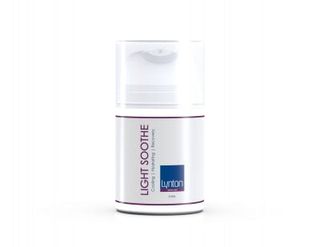They Say This New Acne Scarring Treatment Works Wonders—I Put It to the Test
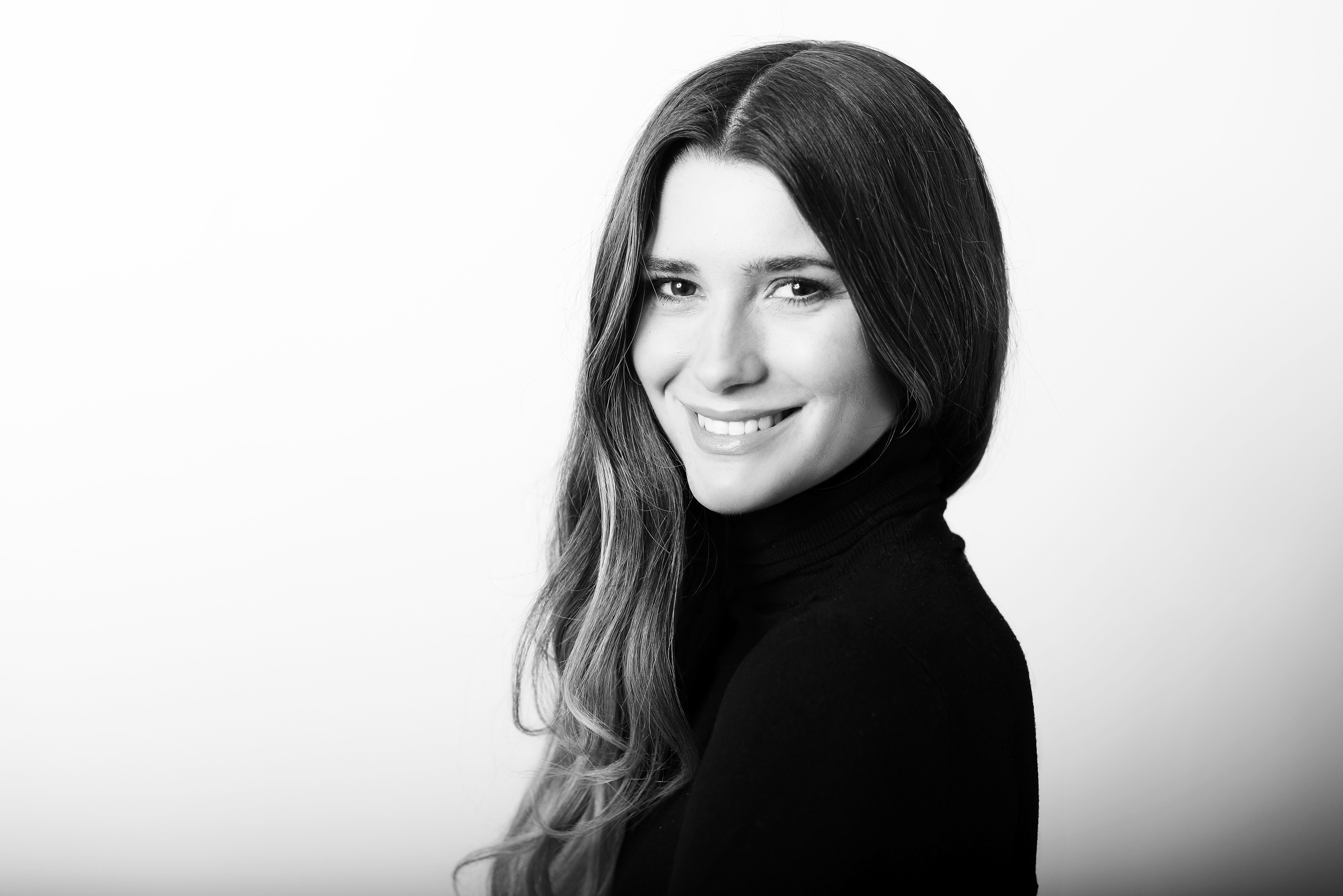
Radiofrequency microneedling has become one of the most popular aesthetics treatments within the industry right now. Recently, aesthetics device manufacturer Lynton launched Focus Dual, a new device that allows clinics to use radiofrequency microneedling (also known as RF microneedling, FYI) to treat a number of skin concerns. I'm someone who developed hormonal cystic acne in their early twenties, and while I've since gotten this back under control with medication, I was left with some uneven skin texture on my chin where the stubborn breakouts persisted. While it's not severe or particularly obvious to those around me, it's something that had bothered me personally which I wanted to address, and I was finding that skincare alone wasn't enough to address my uneven skin texture.
After talking with Debbie Thomas, skincare expert and founder of D.Thomas Clinic in London, I learned that they are one of the first to offer the treatment, and that radiofrequency microneedling can help treat acne scarring and uneven skin texture, amongst many other skincare concerns too. "Combining two clinically proven technologies—radiofrequency and microneedling—that work synergistically, the RF microneedling treatment offers dramatic skin-boosting results," she says. "RF microneedling is a versatile treatment, effective for age management, healthy skin promotion, overall textural improvements, scar reduction and acne reduction."

In some lighting, my acne scarring/uneven texture on my chin is more apparent, and my makeup doesn't go on as smoothly as I'd like it to, as shown here.
Naturally, I jumped at the opportunity to try radiofrequency microneedling for myself. Ahead, you'll find my honest review of my RF microneedling treatment, before and afters and everything you need to know about the innovative treatment.
What is Radiofrequency Microneedling?
So what exactly is radiofrequency microneedling? When I headed to the D.Thomas Clinic, I put the question to my therapist Elinor Hooper, who conducted my course of treatment. She explained that the device uses 25 tiny pinhead needles which puncture the skin. This controlled skin injury triggers the skin's healing response to kickstart collagen and skin regeneration. "Microneedling is really good for refining the skin, helping to even skin texture, while the radio frequency creates heat to tighten and stimulate collagen," she says. "So, the two together help to improve the overall appearance of the skin."
Thanks to needles— which are finer than other competitor devices—and a vacuum suction which you can see above, it draws the skin into the tip evenly before the needles are released, the treatment is more efficient at delivering potent results and triggering the skin into recovery mode to remodel the look of the skin.
My primary concerns were to address the uneven skin texture on my chin, but this treatment can also address a whole range of skincare concerns on both the face and the body. It can treat pigmentation and acne scarring, as well as plump fine lines and help reduce the appearance of enlarged pores too. It also has a tightening and lifting effect, making it ideal for a subtle lift. Plus, it can be used on the body too, and is particularly effective at treating stretch marks.
What can I expect during a radiofrequency microneedling treatment?
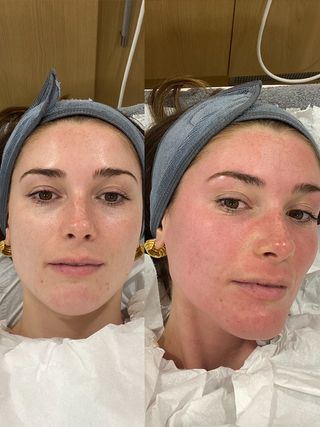
Before my first Dual Focus radiofrequency microneedling treatment, and immediately after.
I was recommended a course of three treatments, each four weeks apart, to get the best results for my individual concerns. Depending on the severity of your concerns, you need fewer or more treatments to achieve your goals. It's recommended that you avoid sun exposure prior to your treatment, so autumn and winter is an ideal time to get started. That said, I had come back from holiday the week before my initial treatment, so my therapist used insulated needles to perform the treatment, which deliver a gentler treatment if your skin is sun-exposed. The insulated needles are also more suitable for darker skin tones, so your therapist will be able to determine which is best for your skin tone, as well as the depth of the needles to achieve the best results for you.
Depending on your local council, you may need to apply numbing cream yourself before having your microneedling treatment done. In some councils, only a medical professional can apply numbing cream. This was the case at D.Thomas Clinic, so I bought a tube of numbing cream and layered it on my skin for 40 minutes before my treatments. That being said, on my first treatment I actually went without numbing cream, and while it was mostly bearable, I would highly recommend using numbing cream beforehand for a more comfortable experience.
On to the question that everyone wants to know. Does it hurt? It feels quite pinchy, and it's particularly so around sensitive areas around the eyes and lips, but you soon get used to the sensation. My therapist treated my face and neck, and she went over the areas of concern two or three times to ensure thorough treatment. As you can see from my after treatment photo, I was quite red and my skin felt hot, but my therapist assured me this was all normal and a good reaction to the treatment. I would describe it as similar to feeling a little sunburnt, and I was this red for around an hour after my treatment (cue running out of the clinic with my biggest sunglasses on as I made my way to the tube station). The redness subsided and I looked less flushed after a couple of hours.
Each treatment lasted for around 45 minutes, and I had three treatments in total, and these were each spaced four weeks apart, and I was given some aftercare advice after each treatment—more on that below.
Radiofrequency Microneedling Aftercare

My skin two days after my radiofrequency microneedling treatment.
In the days after my treatments, my skin was pink, and I could see the track marks from where the needles had punctured my skin. It certainly looks more severe than it was, and I didn't experience any pain whatsoever. This lasted up to four days, after which my skin settled and the bumps has disappeared. Naturally, my skin was more sensitive during this time, so I was given some aftercare tips to ensure my skin healed well.
I only used gentle skincare for up to four days after each treatment, and mostly avoided stronger active ingredients such as retinoids and acids for the duration of my treatment course. Lynton has a cooling serum gel which is designed to be used post-procedure, which I used in the days after my treatment. I stayed out of the sun and wore an SPF each day, which is important as the skin is partiucalty sensitive after this treatment. After a week, I could introduce my salicylic acid cleanser and hyaluronic acid serums as normal.
You can wear makeup 24 hours afterwards, but I tried to go without for as long as possible, as I found my acne-prone skin was easily clogged where my skin was more 'open'. If you do want to wear makeup, mineral-based powder foundations are recommended. It's also advised to avoid swimming, saunas and vigorous exercise where your skin heats up for a couple of days after your treatment.
Radiofrequency Microneedling Results: Before & After
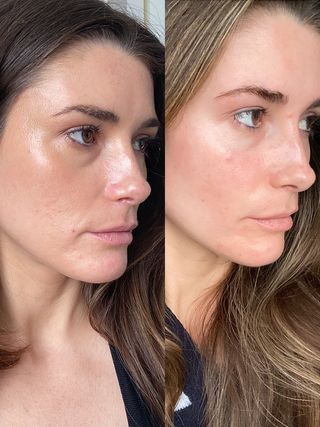
Before my treatment, and one month after my third and final treatment.
It can take up to three months from your first treatment to see the full results, but initial results can be seen after six weeks from the initial treatment. I had my first radiofrequency microneedling treatment at the end of July, and had my final treatment at the end of September. This after picture is about three months after my first treatment, so I'm starting to see the results. Because of the skin healing process and collagen production from microneedling and radio frequency, I'll see my full results in December.
While it's subtle, my skin texture is currently smoother, and my skin feels plumper. The scarring on my chin and jawline is also less prominent, and I feel my overall skin texture has improved; pores are less noticeable and fine lines have been plumped. I've even noticed a little bit of lifting around the corners of my mouth. I'm excited to see my full results after a couple more months where I should see a big improvement in my skin quality—watch this space for another update then.
Is Radiofrequency Microneedling Worth It?
With the results that I've seen so far above, I would really recommend this treatment to anyone who wants to address skin texture concerns, pigmentation or acne scarring, or to just give your skin a boost. The treatment can be uncomfortable and the downtime needs to be managed well, but I feel the results are absolutely worth it. As someone who has previously had microneedling as a standalone treatment, I can say that I've experienced even better results with the addition of radiofrequency to the treatment. For that reason, I would be inclined to book in for further treatments down the line to maintain the results.
How does a radiofrequency microneedling treatment cost?
Treatment cost will vary from clinic to clinic, however, treatment at D.Thomas Clinic starts at £395 for a single treatment, or £1067 for a course of three.
Up Next, I Have Acne Scarring, and These Are the Only Products That Help

Eleanor Vousden is the beauty editor for Who What Wear UK. She was previously deputy editor at Hairdressers Journal, health writer at Woman & Home and junior beauty editor at beauty website Powder. She has also contributed to Wallpaper and Elle Collections with written and styling work.Working as a beauty journalist since 2015 after graduating in fashion journalism at the London College of Fashion, she has been highly commended at the BSME Talent Awards for her work on Powder and also contributed to the title winning Website of the Year at the PPA Awards.Eleanor’s journalistic focus is to provide readers with honest and helpful beauty content. Through words, video and live broadcast, she has interviewed several celebrity makeup artists, hairstylists and top dermatologists throughout her career, as well as celebrities such as Sarah Jessica Parker and Scarlett Johansson. She has a particular interest in finding solutions for acne and eczema, which she has experienced firsthand. She has also amassed a large collection of fragrances and can never say no to a new candle.When she’s not writing or testing the latest beauty product or treatments, she’s on the seafront in her hometown of Brighton and Hove, where she lives with her partner and her miniature dachshund.
-
 Zendaya's Cute Tory Burch Tennis Skirt Is Shockingly Still in Stock—Ready, Go
Zendaya's Cute Tory Burch Tennis Skirt Is Shockingly Still in Stock—Ready, GoI smell a sellout.
By Eliza Huber
-
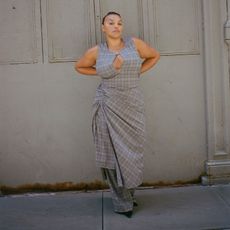 Ganni's Size-Inclusive Collab Is Causing a Scandi Fashion Frenzy
Ganni's Size-Inclusive Collab Is Causing a Scandi Fashion FrenzyShop it before it sells out.
By Drew Elovitz
-
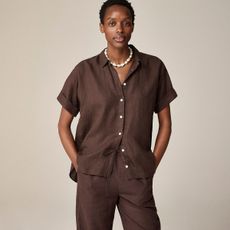 J.Crew Is Having an Epic Linen Sale—These 17 Pieces Need to Come Home With Me
J.Crew Is Having an Epic Linen Sale—These 17 Pieces Need to Come Home With MeSummer prep starts now.
By Allyson Payer
